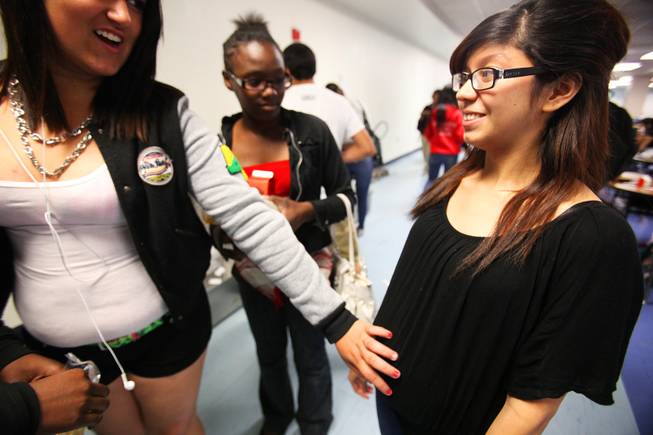
Evaleen Diaz, 18, at Western High School on Thursday, April 26, 2012. Diaz, a senior at Western, is seven months pregnant.
Tuesday, April 23, 2013 | 2 a.m.
Should sex education be a school or a parent's responsibility? Or both?
That's perhaps the most contentious question surrounding Assembly Bill 230, which would change sex education in Nevada from an opt-in to an opt-out program.
Currently, state law requires local school districts to teach about the human reproductive system, sexually transmitted diseases and "sexual responsibility." Parents must sign a consent form at the beginning of the year to allow their children to participate in sex education classes.
AB230 beefs up the language in the state law, requiring that districts provide medically accurate and age-appropriate comprehensive sex education, including topics such as domestic violence, sexual assault and sex trafficking. Students automatically would be enrolled in sex education classes; parents may sign a form to opt their children out of these classes.
Proponents of AB230, such as Planned Parenthood, argue these changes would help curb Nevada's teen pregnancy rate, which is the fourth-highest in the nation.
Critics have taken issue with AB230's opt-out clause, which they argue undermines parents' ability to teach what they feel is appropriate sex education to their children.
Here are 10 facts you should know about sex education and teen pregnancy rates in Nevada:
-
Starting point
The Clark County School District provides comprehensive sex education starting in fifth grade.
-
Early lessons
In fifth grade, Clark County students are taught about the human reproductive system, puberty, and HIV and AIDS. Fifth-graders also learn about personal responsibility and developing open lines of communication with parents and guardians about sex.
-
Eighth-grade lessons
By eighth grade, Clark County students learn about the anatomical terms for the male and female reproductive systems, sexually transmitted diseases, the definition of sexual harassment and contraceptives.
-
Continuing education in high school
In high school, Clark County students learn about the treatment of sexually transmitted diseases, implications of teenage pregnancy, and the role abstinence and contraceptives can play in preventing pregnancy and sexually transmitted diseases.
-
Teen pregnancy rates
In 2008 — the most recent data available for all 50 states — the average teenage birth rate nationally dropped to its lowest level in four decades, according to a Guttmacher Institute study released in February.
The national teen pregnancy rate was 68 per 1,000 teens, a 42 percent decline from its record high of 117 pregnancies per 1,000 teens in 1990.
In 2008, Nevada's teen pregnancy rate was 84 per 1,000 teens.
-
Nevada rate declining
Nevada's average teenage birth rate has been dropping in recent years. In fact, Nevada had the second-largest decline — 9 percent — in its teen pregnancy rate nationally between 2005 and 2008, according to the Guttmacher study.
-
Nevada stands at No. 4
In 2008, Nevada had the fourth-highest teen pregnancy rate in the nation, according to the Guttmacher study.
The highest teen pregnancy rate in 2008 was in New Mexico, followed by Mississippi, Texas, Nevada and Arkansas.
New Hampshire, Vermont, Minnesota, North Dakota and Massachusetts had the lowest teen pregnancy rates.
-
Kids Count data
There were 3,058 births to teenage mothers ages 15 to 19 in 2011, according to a Nevada Kids Count study released this month.
Blacks had the highest teen birth rate, at 66 births per 1,000 teens. Hispanics had the second highest teen birth rate, at 63 births per 1,000 teens.
-
Abortions, live births even among teens
About 45 percent of teenage pregnancies in Nevada result in abortion. About 45 percent result in births, and about 10 percent result in miscarriages, according to the Guttmacher study.
-
Cost of births to taxpayers
In 2006, Nevada spent $83 million in federal and state money to deliver babies to teenagers, according to the Guttmacher study.

Join the Discussion:
Check this out for a full explanation of our conversion to the LiveFyre commenting system and instructions on how to sign up for an account.
Full comments policy